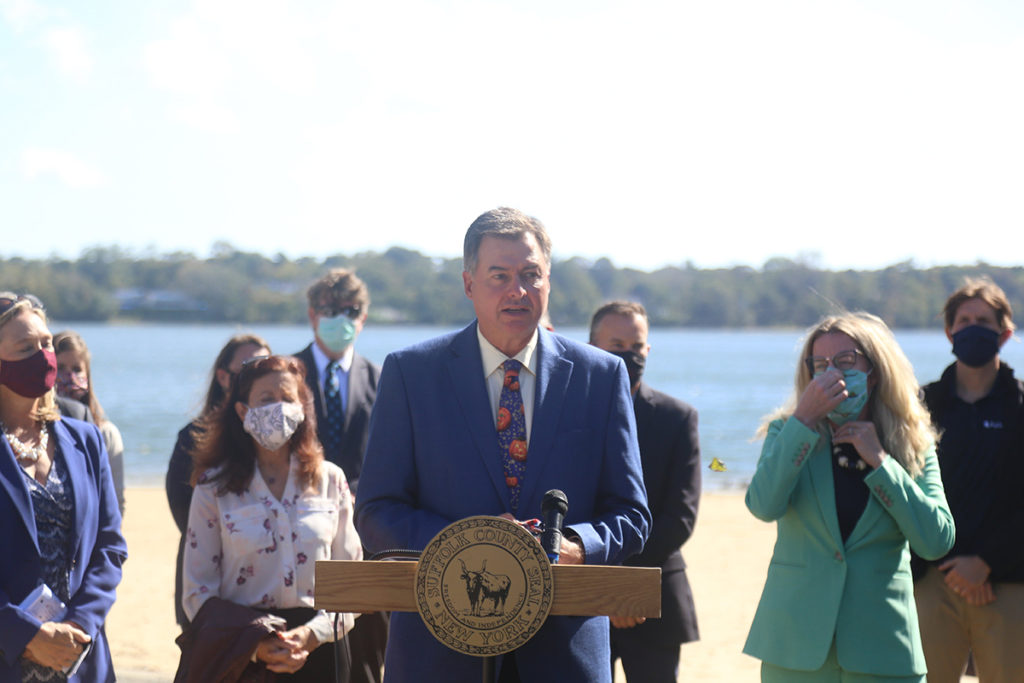Nitrogen-reducing septic systems to be required in all new construction projects

A new law adopted unanimously by the Suffolk County Legislature last week will require the use of nitrogen-reducing septic systems in all new construction projects.
Lawmakers and environmental advocates joined Suffolk County Executive Steve Bellone in Lake Ronkonkoma where he signed the bill into law Thursday.
Mr. Bellone, speaking about the importance and fragility of water quality on Long Island, said the legislation is a “great advance” toward protecting the natural resource.
“We do not have a prosperous future if we’re not protecting water quality,” the county executive said. “It’s everything to us.”
The bill, which will take effect in July 2021, modifies the county’s sanitary code and will require innovative-alternative septic systems to be installed in new home and commercial construction projects in unsewered areas.
The new systems will also be required in single-family home renovations that increase the number of bedrooms to more than five and increase the floor area.
It would also apply to other construction projects, including condominiums and multifamily housing projects that officials say provide greater flexibility for development in downtown areas.
“People say it’s expensive, but this is an investment in our future,” said Suffolk County Legislator Al Krupski (D-Cutchogue). “This is an investment for the next generation to make sure that you can go down and clam somewhere, and you can fish and there will be fish and you can use the beaches.
“That investment is worthwhile,” he added.

The advanced systems can cost upwards of $20,000 to install, nearly double the cost of installing a traditional cesspool. Since 2017, the county has offered grant funding and low-interest financing to help homeowners upgrade their systems. So far, more than 1,082 grants have been issued and 600 innovative-alternative systems have been installed as a result of the program.
The law is a key step outlined in a $4 billion plan released last year that aims to phase out all traditional septic systems over the next five decades. Three years ago, county lawmakers approved similar legislation to close a decades-old loophole and finally ban the installation of new cesspools.
Dr. Chris Gobler, scientist and director of the state Center for Clean Water Technology at Stony Brook University, said Thursday that Suffolk’s water quality went “from first to worst” as a result of nitrogen pollution.
“We know why that happened, we saw the nitrogen levels increase by up to 200% due to onsite septic systems,” he said. “We saw the onset of brown tides, red tides, rust tides, blue green algae, all of which were contributing to the collapse of those fisheries.”
The new legislation, he said, represents a “changing course” on water for future generations.
It’s also a “game changer” for developers, who will now be able to use the ‘Appendix A’ systems in larger development projects, according to Mitchell Pally, chief executive officer of the Long Island Builders Institute.
“Such systems will provide a meaningful benefit to both our economic development opportunities as well as protect our environment in the county,” Mr. Pally said, noting that the systems could be used in housing projects for both young people and senior citizens.
Of the more than 360,000 residential existing onsite sewage disposal systems in the county, officials estimate that 252,000 systems may pre-date requirements for a septic tank and may consist of a cesspool only.
The Subwatersheds Wastewater Plan released in 2019 calls for the creation of a countywide wastewater management district and unidentified revenue stream to be in place in order to help homeowners finance their septic upgrades. It also calls for code changes like requiring the new systems in new construction, though the bill passed last week does not address a funding source for homeowners.
The bill was backed by environmental advocates including Citizens Campaign for the Environment, Group for the East End, Defend H20, The Nature Conservancy and the Peconic Estuary Program.
Officials estimate that the policy change could impact 1,000 residential properties each year.
“This will remove roughly 20,000 pounds of nitrogen each year,” said Kevin McDonald, conservation policy advisor for the Nature Conservancy, who said that equates to approximately 30 pallets of nitrogen-rich fertilizer. “This is a seminal moment for the county’s environment.”








